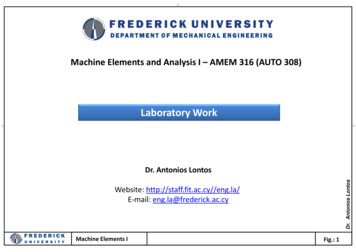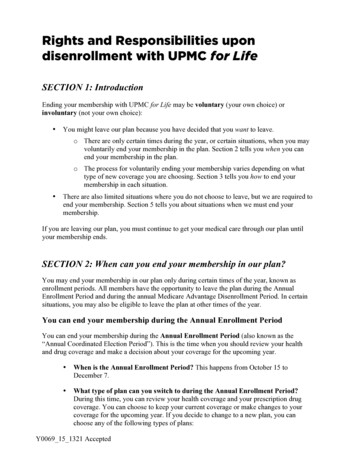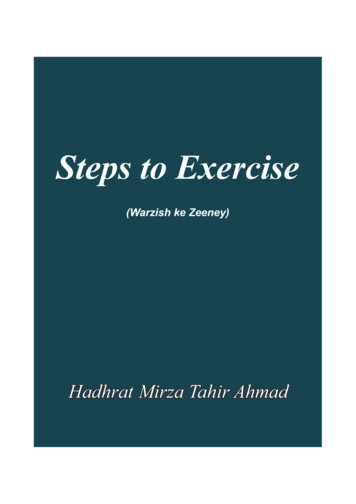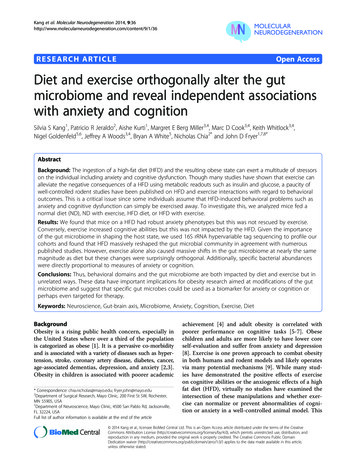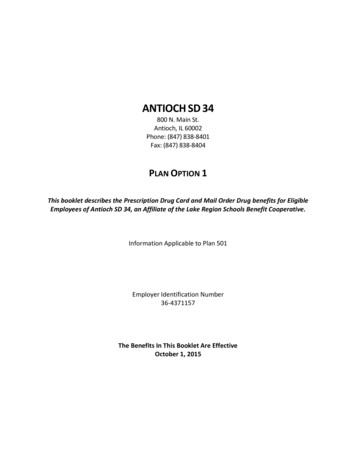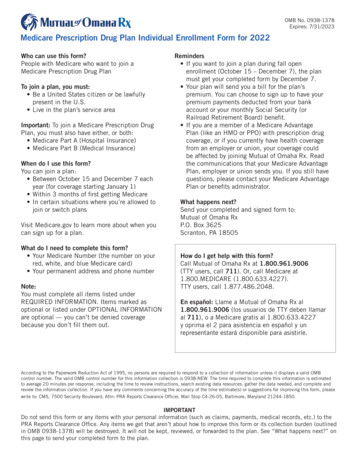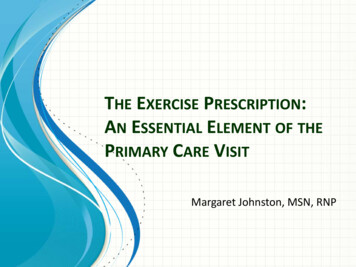
Transcription
THE EXERCISE PRESCRIPTION:AN ESSENTIAL ELEMENT OF THEPRIMARY CARE VISITMargaret Johnston, MSN, RNP
Learning Objectives Review national statistics and trends Describe exercise benefits Examine essential steps in patient assessmentand counseling Delineate four components of exerciseprescription Address special population needs in preparingthe exercise prescription Evaluate community and other resources
Current Physical ActivityRecommendations 30-40 minutes/day moderate intensity PA, onmost days of the week 150 minutes of moderate or 75 minutes ofvigorous activity weekly 60 minutes per day for children Can be incorporated into all daily activitiesincluding work and leisure activities in shortbouts of 10 to 15 minutesUS Department of Health & Human Services. Physical Activity Guidelines forAmericans. ault/aspx.Accessed January 7, 2015.
Current National Statistics: PAAdherence Rates 47 % of adults met PA guidelines for aerobicactivity 22.4% of adults met the guideline goals formuscle strengthening 18.8% of adults 18 years old and over met bothaerobic and muscle strengthening standards Approximately, 1/3 of adults do no exercise intheir leisure timeCenters for Disease Control and Prevention. Health United States, 2010. http//:www.cdc.gov/nchs/data/hus/hus10.pdf. 2011:260. Accessed January 7, 2015
Other National Data PA is less common among women than men PA participation declines with advancing age Non-Hispanic blacks and Hispanic adultsmore likely to be inactive than Non-Hispanicwhites Higher education levels associated with PAguideline adherenceRoger, VL. Circulation. 2012;125(22):e2-e220.
Summary of Major Research Findings Any physical activity is better than none Both aerobic and resistance exercise are helpful Many health risks are reduced and healthoutcomes improved Most benefits occur with at least 150 minutes ofmoderate activity Additional benefits with more frequent, longerlasting and more intense PA Benefits of PA far outweigh risksUS Department of Health and Human Services. 2008 Physical Activity Guidelinesfor Americans. http://health.gov/PAguidelines.pdf/paguide.pdf. 2008. AccessedJanuary 8, 2015.
Health Benefits with Strong EvidenceCVD-Related BenefitsOther Benefits Lower CAD, HTN and CVArisk Lower dyslipidemia risk Lower risk for metabolicsyndrome and DM2 Prevention of weight gain Lower risk off early death Lower risk of breast andcolon cancer Reduced depression Better cognitive function inolder adults Improved fitness and senseof well-beingUS Department of Health and Human Services. 2008 Physical Activity Guidelinesfor Americans. http://health.gov/PAguidelines.pdf/paguide.pdf. 2008. AccessedJanuary 8, 2015.
Benefits of Increasing Exercise for theAging Population Improved conditioning, strength, flexibility, andoverall physical fitness Improved mobility and reduced onset ofmobility-related disability Reduced risk of cardiovascular disease,thromboembolic stroke, hypertension, type 2diabetes mellitus, osteoporosis, obesity, coloncancer, breast cancer, anxiety, depression, andcognitive decline
Benefits of Increasing Exercise for theAging Population Reduced likelihood of falls and relatedinjuries Possible decreased incidence and severity offunctional limitations Improved patient outcomes in several chronicconditions, including mood disorders,dementia, chronic pain, congestive heartfailure, stroke, constipation, and sleepdisorders
Relevant Citations Hamer M, Lavoie, KL, Bacon SL. Taking up physical activity in later life and health ageing:the English longitudinal study of ageing. Br J Sports Medi 2014; 48:230Mänty M, Heinonen A, Leinonen R, et al. Long-term effect of physical activity counseling onmobility limitation among older people: a randomized controlled study. J Gerontol A Biol SciMed Sci 2009; 64:83.King AC, Guralnik JM. Maximizing the potential of an aging population. JAMA 2010;304:1944Morey, M.C. (Oct 20, 2014). Physical activity and exercise in the elderly. UpToDate (Online).Morey MC, Sloane R, Pieper DF, et al. Effect of physical activity guidelines on physicalfunction in older adults. J AM Geriartr Soc 2008; 56: 1873.Pescatello, L.S, Arena, R. et al.(Eds.). (2014). ACSM’s Guidelines for exercise testing andprescription (9th ed). Baltimore, M.D.: Wolters Kluwer/Lippincott Williams & Wilkins.Villareal DT, Chode S, Parimi N, et al. Weight loss, exercise, or both and physical functionin obese older adults. N Engl J Med 2011; 364: 1218.
Value of Initiating Exercise for theAging Population Benefits occur with initiation and maintenanceof exercise Even previously sedentary who start to exerciseas late as age 85 demonstrate a significantsurvival improvement Patients with physical limitations experience anattenuation of the onset of mobility-relateddisability Improved fitness with exercise has been notedeven among institutionalized older adultsPahor M, Guralnik JM, Ambrosius WT, et al. Effect of structured physical activity on prevention of major mobility disabilityin older adults: the LIFE study randomized clinical trial. JAMA 2014; 311:2387.Stessman J, Hammerman-Rozenberg R, Cohen A, et al. Physical activity, function, and longevity among the very old. ArchIntern Med 2009; 169:1476.
Exercise is a free medicine available tojust about anyone.
Starting the Process Office-based short intervention as the nexusof change Majority of patients have greatest number ofvisits with PCP Lost opportunity for patient education asmany providers do not take the time to havethis discussionJacobson DM, Strohecker L, Compton MT, Katz DL. Physical activitycounseling in the adult primary care setting: position statement of theAmerican College of Preventive Medicine. Am J Prev Med 2005; 29:158.
Cognitive-Behavioral Strategies –Class 1 Recommendations Goal setting (A)Self-monitoring (A)Frequent and prolonged contact (B)Feedback and reinforcement (A)Self-efficacy enhancement (A)Motivational interviewing (A)Artinian NT, Fletcher GF, Mozaffarian D, et al. Interventions to promote physicalactivity and dietary lifestyle changes for cardiovascular risk factor reduction inadults: a scientific statement from the American Heart Association. Circulation2010; 122:406.
The Five A Approach for LifestyleCounseling AssessAdviseAgreeAssistArrangePescatello, L.S, Arena, R. et al.(Eds.). (2014). ACSM’s Guidelines for exercise testing andprescription (9th ed). Baltimore, M.D.: Wolters Kluwer/Lippincott Williams & Wilkins.Meriwhether RA, et al. Am Fam Phys. 2008;77(8):1129-1136.
Assess Current exercise and PA level Awareness of exercise resources and healthbenefits Perceived barriers and confidence in ability tochange Identification of one strategy to increaseactivity levelMeriwhether RA, et al. Am Fam Phys. 2008;77(8):1129-1136.
Advise Discuss risk factors/biochemical markers as abasis to increase activity Promote exercise as the best medicine formany problems Be specific about what behaviors will reducerisk factorsMeriwhether RA, et al. Am Fam Phys. 2008;77(8):1129-1136.
Agree Collaborate in goal setting Provide alternative ways to meetobjectives Form a plan– Record in medical documentation– Have patient write down interim goalsMeriwhether RA, et al. Am Fam Phys. 2008;77(8):1129-1136.
Assist Take realistic stock of patient’s situation Recount perceived barriers Offer several approaches and resourcesas solutions Be aware of evolving community,internet and digital resourcesMeriwhether RA, et al. Am Fam Phys. 2008;77(8):1129-1136.
Arrange Make necessary referrals Provide information regarding resources andhandouts Ensure follow up appointment Use friendly phone call or text to encouragechange Review exercise plan and progress next visitMeriwhether RA, et al. Am Fam Phys. 2008;77(8):1129-1136.
Health Screening Prior to PA Initiation CV event risk is increased during vigorousactivity; however absolute risk of cardiac eventis low in healthy people Exercise confers CV benefits that far outweighrisks for light to moderate intensity exerciseprograms Exercise testing poor predictor of CVD events inasymptomatic individuals Conflicting recommendations among majororganizationsPescatello, L.S, Arena, R. et al.(Eds.). (2014). ACSM’s Guidelines for exercise testing andprescription (9th ed). Baltimore, M.D.: Wolters Kluwer/Lippincott Williams & Wilkins.
ACSM Recommendations Vast majority do not require exercise testingprior to initiating a moderate intensity PAprogram Use a self-guided screening tool such as thePhysical Activity Readiness Questionnaire(PAR-Q) or the modified AHA/ACSMHealth/Fitness Facility PreparticipationScreening QuestionnairePescatello, L.S, Arena, R. et al.(Eds.). (2014). ACSM’s Guidelines for exercise testing andprescription (9th ed). Baltimore, M.D.: Wolters Kluwer/Lippincott Williams & Wilkins.
ACSM Recommendations forAdolescents and Adults Identify those with symptoms/signs thatsuggest CV, pulmonary or metabolic disease– Chest pain– SOB with mild exertion– Dizziness or syncope– Orthopnea/PND– Ankle edema– Arrhythmias or known heart murmur– Intermittent claudicationPescatello, L.S, Arena, R. et al.(Eds.). (2014). ACSM’s Guidelines for exercise testing andprescription (9th ed). Baltimore, M.D.: Wolters Kluwer/Lippincott Williams & Wilkins.
PAR-Q Has your healthcare provider ever said that you have a heartcondition and that you should only do physical activityrecommended by a healthcare provider?Do you feel pain in your chest when you do physical activity?In the past month, have you had chest pain when you werenot doing physical activity?Do you lose your balance because of dizziness or do you everlose consciousness?Do you have a bone or joint problem (for example, back,knee or hip) that could be made worse by a change in yourphysical activity?Exercise is Medicine. Health Care Provider’s Action HCPActionGuide LR.pdf.Acessed February 15, 2015
PAR-Q Score InterpretationAll ‘no’ answers Can begin independent PAprogram Exercise rx based on 2008guidelines Referrals to professionalcertified trainer or otherfitness specialist‘Yes’ answers Use clinical judgment todetermine if person needssupervision or can bestarted slowly High risk individuals need tobe referred to clinicalexercise program such ascardiac or pulmonaryrehabilitationExercise is Medicine. Health Care Provider’s Action HCPActionGuide LR.pdf.Acessed February 15, 2015
ACSM Recommendations forAdolescents and Adults For those with diagnosed disease, determinewho would benefit from a physical exam withexercise testing Individualize recommendations regardingstarting and progression of exercise programto minimize potential for CV event Preparticipation health screening is differentthan a periodic medical examPescatello, L.S, Arena, R. et al.(Eds.). (2014). ACSM’s Guidelines for exercise testing andprescription (9th ed). Baltimore, M.D.: Wolters Kluwer/Lippincott Williams & Wilkins.
ACSM Recommendations for OlderAdults Most do not require exercise testing prior toinitiating a moderate intensity PA program Presence of multiple risk factors indicatesneed for physical exam and exercise testingfor prior to strenuous exercisePescatello, L.S, Arena, R. et al.(Eds.). (2014). ACSM’s Guidelines for exercise testing andprescription (9th ed). Baltimore, M.D.: Wolters Kluwer/Lippincott Williams & Wilkins.
Risks of Exercise Musculoskeletal injury due to overuse mostcommon Others:– Reactive airway disease– Arrhythmias– SCD/MI– RhabdomyolysisPescatello, L.S, Arena, R. et al.(Eds.). (2014). ACSM’s Guidelines for exercise testing andprescription (9th ed). Baltimore, M.D.: Wolters Kluwer/Lippincott Williams & Wilkins.
Preparing the ExercisePrescription
Exercise Prescription and ReferralFormExercise is Medicine. Health Care Provider’s Action HCPActionGuide LR.pdf.Acessed February 15, 2015
Aerobic Activity 150 minutes or more of moderate intensityexercise per week 75 minutes or more of strenuous exercise perweek Combination of the above to achievetargeted exercise volume Exercise may be accumulated in bouts of 10minutes or more over the dayUS Department of Health & Human Services. Physical Activity Guidelines for elines/default/aspx. Accessed January 7, 2015.
OHSU Cardiac Rehabilitation ExerciseProgression Plan FREQUENCY– Week 1-3: Three times per day– Week 4-6: Two times per day– Week 7-10: Once per f
OHSU Cardiac Rehabilitation ExerciseProgression Plan WEEK WARM-UP BRISK WALK COOL DOWNWeek 1 - 5 minutes 5 minutes 5 minutesWeek 2 - 5 minutes 8 minutes 5 minutesWeek 3 - 5 minutes 11 minutes 5 minutesWeek 4 - 5 minutes 14 minutes 5 minutesWeek 5 - 5 minutes 17 minutes 5 minutesWeek 6 - 5 minutes 20 minutes 5 minutesWeek 7 - 5 minutes 23 minutes 5 minutesWeek 8 - 5 minutes 26 minutes 5 minutesWeek 9 - 5 minutes 29 minutes 5 minutesWeek 10 - 5 minutes 30 minutes 5 m.pdf
Resistance Training Major muscle group training 2-3 timesweekly using ‘whole body’ approach Selected muscle group training using the‘split’ approach 3 times weekly 48 hours between training the same musclegroupPescatello, L.S, Arena, R. et al.(Eds.). (2014). ACSM’s Guidelines for exercise testing andprescription (9th ed). Baltimore, M.D.: Wolters Kluwer/Lippincott Williams & Wilkins.
Flexibility Exercises targeting major muscle groups 10-30 second hold to point of tightnesseffective for joint ROM enhancement inyounger adults 30-60 second hold may benefit older adults Minimum 2-3 times weekly improves stretchhold; most effective when done dailyPescatello, L.S, Arena, R. et al.(Eds.). (2014). ACSM’s Guidelines for exercise testingand prescription (9th ed). Baltimore, M.D.: Wolters Kluwer/Lippincott Williams &Wilkins.
Neuromotor Exercise – FunctionalFitness Involves balance, coordination, gait, agilityand proprioreceptive training May be beneficial for young and middle ageadults; definitively helpful for aging persons Optimal frequency not known; some supportfor 2-3 times a week for a total of 60 minutesor more a weekPescatello, L.S, Arena, R. et al.(Eds.). (2014). ACSM’s Guidelines for exercise testing andprescription (9th ed). Baltimore, M.D.: Wolters Kluwer/Lippincott Williams & Wilkins.
Foam Rolling or Myofascial Release Perform both before and after exercise Engage all major muscle groups especiallythose that are painful or are cramping Roll slowly over each muscle group pausingfor 2-5 seconds over muscle segments Pause for longer periods up to 30 secondsover muscle ‘knots’ Repeat twice over troublesome t-hurt
Calf Rolling for -does-it-hurt
Iliotibial Band -it-hurt
Hip Extensor -it-hurt
Exercise Progression Summary
ExRx for the Aging Population
Exercise Program Components Aerobic exerciseMuscle strengtheningFlexibilityNeuromotor exercise including balancePescatello, L.S, Arena, R. et al.(Eds.). (2014). ACSM’s Guidelines for exercisetesting and prescription (9th ed). Baltimore, M.D.: Wolters Kluwer/LippincottWilliams & Wilkins.
Current AHA/ACSM ActivityRecommendations More intensity and longer exercise duration lead togreater health benefits Recommended aerobic activity levels are inaddition to ADL 3 options:– Minimum of 30 minutes of moderate-intensity aerobicactivity on five days each week– Minimum of 20 minutes of vigorous-intensity activityon three days each week– Combination of the twoPescatello, L.S, Arena, R. et al.(Eds.). (2014). ACSM’s Guidelines for exercise testing andprescription (9th ed). Baltimore, M.D.: Wolters Kluwer/Lippincott Williams & Wilkins.Nelson ME, Rejeski WJ, Blair SN, et al. Physical activity and public health in older adults:recommendation from the American College of Sports Medicine and the American HeartAssociation. Circulation 2007; 116:1094.
Initiating Aerobic Exercise Exercise can be spread throughout the day toachieve recommended activity levels Obese individuals may need 300 minutes ofactivity in addition to diet to manage weightcontrol Chronically ill may not be able to achieveminimal levels of recommended activity butshould be as active as possible
Assessing Exercise Intensity Use of absolute METS inappropriate for ageingpopulation Self reported effort better for determining activityintensity Borg Scale– Moderate exertion rated 5-6/10; associated noticeableincrease in respiratory and heart rate– Strenuous exertion rated 7-8/10 associated with largeincrease in heart and respiratory rate– Should be able to carry on conversation while exercising;if not, activity is too strenuousPescatello, L.S, Arena, R. et al.(Eds.). (2014). ACSM’s Guidelines for exercise testing andprescription (9th ed). Baltimore, M.D.: Wolters Kluwer/Lippincott Williams & Wilkins.
Muscle-Strengthening for IncreasedPerformance Strengthening activities should be done at least two nonconsecutive days per week Exercises should target 8 to 10 major muscle groups at anappropriate exertion level 10 to 15 repetitions of each exercise at a moderate to highlevel of intensity with gradually increase in resistance ideal Muscle soreness is normal at first and should subside in afew weeks More gradual incremental strengthening best for thosewith chronic pain to maximize tolerance and exerciseadherencePescatello, L.S, Arena, R. et al.(Eds.). (2014). ACSM’s Guidelines for exercise testing andprescription (9th ed). Baltimore, M.D.: Wolters Kluwer/Lippincott Williams & Wilkins.
Muscle-Strengthening – HelpfulHints Initial weight should be one that an individual can liftabout eight times When able to perform 10-15 repetitions, weight canbe increased again until only 8 repetitions can be done Breathing should be normal while lifting weights,exhaling as the weight is lifted Movements should be slow through a repetition: twoto three seconds to lift, hold for one second, and threeto four seconds to return to the starting position Avoid locking the joints in a tightened position.Pescatello, L.S, Arena, R. et al.(Eds.). (2014). ACSM’s Guidelines for exercise testing andprescription (9th ed). Baltimore, M.D.: Wolters Kluwer/Lippincott Williams & Wilkins.
Flexibility Little research on impact on physical wellnessbut basis for performing all activities Helpful tips:– Do twice a week for at least 10 minutes– Perform after aerobic or strengthening activitiesafter warm up– Breathe normally; do not bounce into a stretch.– Stretch slowly into the desired position and hold;hold for 10 to 30 seconds– Should feel a slight pull but should not stretch to thepoint of pain.Pescatello, L.S, Arena, R. et al.(Eds.). (2014). ACSM’s Guidelines for exercise testing andprescription (9th ed). Baltimore, M.D.: Wolters Kluwer/Lippincott Williams & Wilkins.
Chest ion.htm
Thigh ion.htm
Neuromotor Exercise Balance problems common in elderly adults Balance exercise improve stability and may preventfalls and related injuries Participation in group classes improves stability andmay prevent falls and associated injuries Selected activities:– Tai Chi– Gait pattern challenges such as heel-to-toe walking– One foot balancing to increase center of gravityawareness– Often combined with strengthening exercisesLin HW, Bhattacharyya N. Balance disorders in the elderly: epidemiology andfunctional impact. Laryngoscope 2012; 122:1858.Sherrington C, Lord SR, Finch CF. Physical activity interventions to prevent falls
Neuromotor Exercise – Balance .htm
Neuromotor Exercise – One ption.htm
Patients with Multiple Morbidities Chronic conditions increase with age Likely 50 percent of patients with diabetes willalso have arthritis 30 percent will have coronary disease, or both. The American College of Sports Medicine’sinitiative, Exercise is Medicine provides patienthandouts with specific exercise prescriptionsavailable htm
Obesity Start with non-weightbearing exercise Avoid high impact activity due topossible orthopedic stress Duration and frequency as tolerated Premeal exercise prior to breakfast bestdue to increase in lipolysisPescatello, L.S, Arena, R. et al.(Eds.). (2014). ACSM’s Guidelines for exercise testing andprescription (9th ed). Baltimore, M.D.: Wolters Kluwer/Lippincott Williams & Wilkins.
Arthritis Select exercises that minimize joint stress Start strengthening at low intensity; progress aspain level permits Emphasize flexibility and full ROM Avoid during acute flares Warn that joint pain may increase after activity;ice area to prevent inflammation Moderate physical activity if pain persists/workwith pain med timingPescatello, L.S, Arena, R. et al.(Eds.). (2014). ACSM’s Guidelines for exercise testing andprescription (9th ed). Baltimore, M.D.: Wolters Kluwer/Lippincott Williams & Wilkins.
Osteoporosis Standard PA recommendations apply but greaterplaced on weight-bearing, balance andstrengthening activities Excessive weight bearing with the initiation ofexercise may increase the risk of fractures Individuals with previous osteoporotic fracturesrequire more individualized program Should avoid sudden movements, jarring ortwisting movement and heavy lifting Best to consult a professional therapist for activityplan after a fracture to relieve pain and regainmobility initiallyPescatello, L.S, Arena, R. et al.(Eds.). (2014). ACSM’s Guidelines for exercise testingand prescription (9th ed). Baltimore, M.D.: Wolters Kluwer/Lippincott Williams &Wilkins.
Diabetes Monitor blood sugar because hypoglycemia orhyperglycemia can occur with exercise Consume a meal 1-3 hours before exercising,administer insulin at least 1 hour before exercise, and,if the blood glucose level is greater than 250 mg/dL,check urine for ketones Supplement energy (caloric) intake every 30 minutesand maintain adequate fluid replacement Monitor the glucose level, increase energy (caloric)intake for 12-24 hours following activity, and expectpostexercise hypoglycemia; thus, appropriately adjustinsulin dosingPescatello, L.S, Arena, R. et al.(Eds.). (2014). ACSM’s Guidelines for exercise testingand prescription (9th ed). Baltimore, M.D.: Wolters Kluwer/Lippincott Williams &Wilkins.
Functionally Limited or Frail Go slow and start low, e.g., walk for 5 minutes daily tostart Training specificity – focus on doing a necessaryactivity with confidence Even modest activity/strengthening helps improvefunctional capacity Dose response – association between intensity andoutcome– Higher intensity will yield better outcomes– Older institutionalized adults had improvement in kneestrength, six-minute walk distance, chair stands, stairclimbing with low-intensity trainingPescatello, L.S, Arena, R. et al.(Eds.). (2014). ACSM’s Guidelines for exercise testingand prescription (9th ed). Baltimore, M.D.: Wolters Kluwer/Lippincott Williams &Wilkins.
Aging Adult ExerciseRecommendation Bibliography Dubbert PM, Morey MC, Kirchner KA et al. Counseling for home-basedwalking and strength exercise in older primary care patients. Arch InternMed. 2008; 168:979. Hamer M, Lavoie KL, Bacon SL. Taking up physical activity in later life andhealthy ageing: the English longitudinal study of ageing. Br J SportsMed. 2014; 48: 239. Pescatello, L.S, Arena, R. et al.(Eds.). (2014). ACSM’s Guidelines fortesting and prescription (9th ed). Baltimore, M.D.: WoltersKluwer/Lippincott Williams & Wilkins. Morey, M.C. (Oct 20, 2014). Physical activity and exercise in the elderly.UpToDate (On-line). Available y-and-exercise-inolder-adults? Villareal DT, Chode S, Parimi N, et al. Weight loss, exercise, or both andphysical function in obese older adults.N Engl J Med. 2011; 364: 1218
ExRx.Net Exercises in all four categories of exercise Calculators for exercise testing andprogression Suggests programs for specific exercisegoals Patient friendly handouts and links totrackers
Exercise is Medicine Exercise is Medicine– Address: http://exerciseismedicine.org– Resources Health Care Provider ToolkitPhysical Activity Readiness QuestionnaireRisk Assessment FormRisk Management Decision TreeExercise /Prescription and Referral FormLinks to local resources
Other Resources Commmunity resources Walking programs– For patients:http://www.startwalkingnow.org/why start walking.jsp– For gHealthy/WorkplaceWellness/WorkplaceWellness UCM 460416 SubHomePage.jsp
Leveraging for Success Make it mutualIndividualize the prescriptionMake it real; life does get in the wayPractice what you preach
Take Home Message Exercise as a free medicine is available to justabout everyone An exercise prescription provides thestructure so that the patient can realize realhealth benefits no matter what their baselinecondition
QUESTIONS?
Jan 07, 2015 · ACSM Recommendations Vast majority do not require exercise testing prior to initiating a moderate intensity PA program Use a self-guided screening tool such as the Physical Activity Readiness Questionnaire (PAR-Q) or the modified AHA/ACSM Health/



